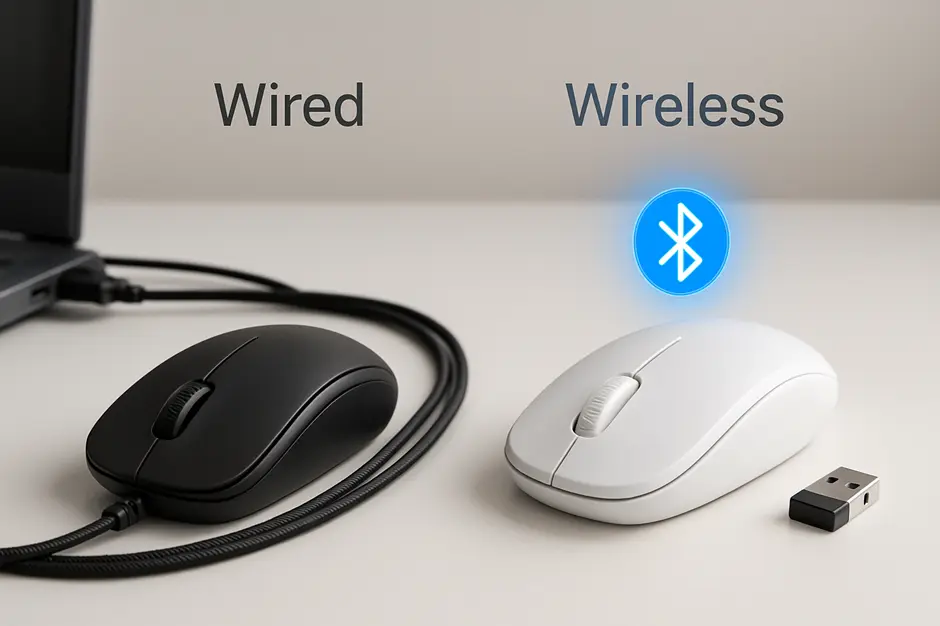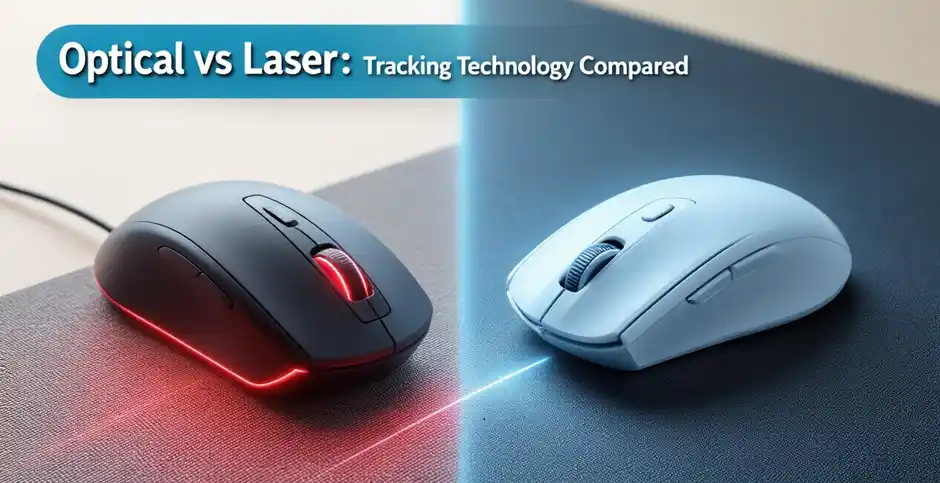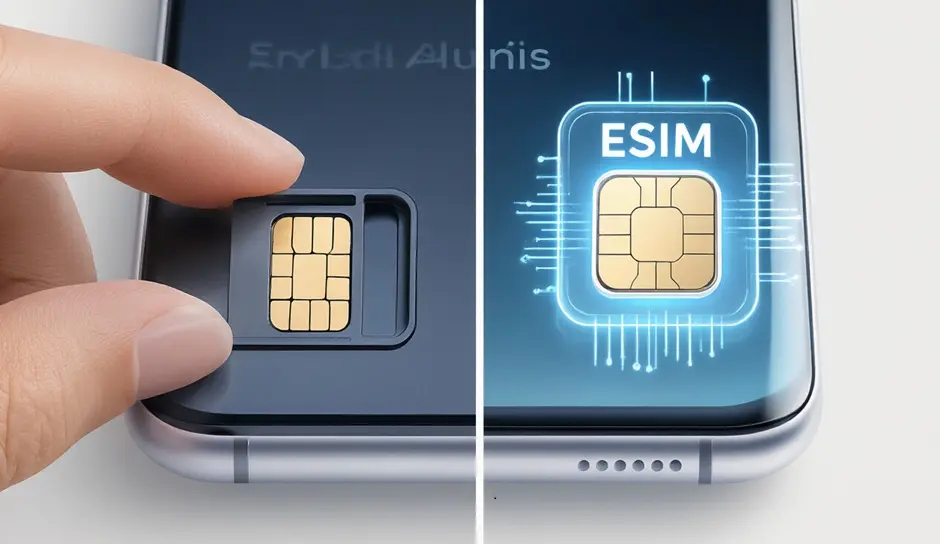You’re staring at your mouse right now, aren’t you? That little device you probably take for granted until it stops working.
For something we use literally thousands of times daily, it’s wild how little thought most of us put into choosing between wired vs. wireless mouse options. Yet this small decision affects everything from your gaming performance to how your workspace looks.
I’ve tested dozens of mouse across both categories, and let me tell you – the “right” choice isn’t as obvious as tech bros on Reddit would have you believe. What matters is matching the mouse to YOUR specific needs.
By the end of this guide, you’ll know exactly which type belongs on your desk.
Understanding Wired Mouse Advantages
A. Reliable Connection Without Interference
Wired mouse have one killer advantage – they just work. Every. Single. Time.
No drop-outs mid-game. No cursor freezing when you’re making that crucial Photoshop selection. No mysterious disconnections during your Zoom presentation.
Why? The physical connection means zero signal interference. Your neighbor’s WiFi, your microwave, or that Bluetooth speaker won’t mess with your mouse’s connection. For professionals who can’t afford random disconnections or gamers who need absolute reliability, this consistency is gold.
B. No Battery Required
Ever had your wireless mouse die during an important task? Yeah, that’s not happening with a wired mouse.
Plug it in and forget it. No charging cables cluttering your desk. No battery indicators to monitor. No sudden power deaths at the worst possible moment.
This continuous power supply is especially nice for marathon gaming sessions or long workdays. Your mouse will keep going as long as you do.
C. Typically Lower Cost
Want more bang for your buck? Wired mouse typically cost less than their wireless counterparts with similar features.
A high-quality wired gaming mouse might cost $30-50, while wireless versions with comparable specs often run $70-100+. The tech behind wireless connectivity and batteries adds to manufacturing costs.
For budget-conscious shoppers or those outfitting an entire office, these savings add up quickly.
D. Slightly Better Response Time for Gaming
For competitive gamers, every millisecond counts. Wired mouse generally offer lower latency – the delay between moving your mouse and seeing that movement on screen.
Most wired mouse have response times around 1ms, while even good wireless mouse typically hit 2-8ms. This tiny difference might seem insignificant, but in fast-paced games where split-second decisions matter, wired mouse give you that slight edge.
Pro gamers often stick with wired mouse for tournaments where every advantage counts.
Exploring Wireless Mouse Benefits
A. Freedom of Movement Without Cable Restrictions
Cutting the cord on your mouse feels like taking off handcuffs you didn’t know you were wearing. Suddenly, you’re not fighting with a cable that snags on your coffee mug or gets tangled with your keyboard wire.
Want to lean back in your chair during a video call? Go for it. Need to control a presentation while standing a few feet from your laptop? No problem. That wireless mouse follows you wherever you go within range (typically 30+ feet depending on the model).
Gamers especially feel the difference. No more cable drag affecting those split-second movements when you’re in the middle of an intense firefight. Just pure, unrestrained motion.
B. Reduced Desk Clutter
Look at your desk right now. Cables everywhere, right? A wireless mouse instantly eliminates one of those cables, creating a cleaner workspace.
This isn’t just about looking nice. A decluttered desk actually helps you think better. There’s a reason minimalist setups are so popular on productivity blogs and YouTube channels. Fewer visual distractions = better focus.
Plus, cable management becomes way simpler. One less cord to thread through those desk organizers or tape down to prevent it from falling behind your desk (again).
C. Enhanced Portability for Travel
Throwing a wireless mouse in your laptop bag is a no-brainer. No untangling required, no awkward wrapping around your device. Just grab and go.
For digital nomads and business travelers, this convenience is huge. Working from a cramped airplane tray table? A wireless mouse gives you flexibility to position your hand comfortably without cord constraints.
Most modern wireless mouse are designed with portability in mind, featuring:
- Compact designs
- Built-in storage for USB receivers
- Quick on/off switches to save battery
- Protective carrying cases (for premium models)
D. Multiple Device Connectivity Options
The best wireless mouse today come with multi-device pairing capabilities. Switch between controlling your laptop, tablet, and even smart TV with a simple button press.
This feature is a game-changer if you’re:
- Working across multiple devices
- Sharing your mouse between work and personal computers
- Presenting from different machines
Some premium models can connect to three or more devices simultaneously, letting you seamlessly bounce between workstations without disconnecting and reconnecting.
E. Modern Aesthetic Appeal
Let’s talk about looks. Wireless mouse just look better on your desk. There’s something undeniably sleek about a cordless peripheral sitting there, ready for action.
Manufacturers know this and design accordingly. Wireless models often feature:
- More attention to surface materials
- Cleaner lines
- Creative lighting elements
- Premium finishes
The aesthetic boost extends beyond the mouse itself. Your entire workspace gains an instant upgrade when you eliminate that snaking cable from the visual equation.
Performance Comparison
A. Latency and Response Time Differences
The battle between wired and wireless mouse often comes down to those crucial milliseconds. Wired mouse typically win here – they deliver input signals instantly through that physical connection. No middleman, no delay.
Wireless mouse have gotten ridiculously better, though. Modern ones have latency as low as 1ms, which is pretty much imperceptible to most humans. But there’s a catch – not all wireless mouse are created equal. Budget options might hit 8-16ms delays, which gamers can definitely feel.
The tech matters too. Bluetooth mouse generally have higher latency (around 8-30ms) compared to RF wireless mouse with dedicated receivers (1-8ms). If you’re editing video or playing competitive games, those milliseconds actually matter.
B. Precision and DPI Capabilities
DPI (dots per inch) measures how sensitive your mouse is. Higher DPI means your cursor moves further with less physical movement.
Here’s the truth: both wired and wireless mouse can reach insanely high DPI levels now. We’re talking 16,000+ DPI that nobody actually needs. The difference isn’t in the max DPI anymore, but in how consistently they track.
Wired mouse maintain more consistent tracking since they don’t deal with potential signal interference. Wireless mouse can occasionally hiccup if there’s interference from other devices, especially in crowded wireless environments.
C. Weight Considerations and Hand Fatigue
Wireless mouse have to carry batteries, making them typically heavier than their wired counterparts. A wired mouse might weigh 80-90g while wireless options often hit 100-120g.
This extra weight impacts how the mouse feels during long sessions. Lighter mouse generally cause less fatigue during extended use. Your hand doesn’t have to work as hard to move and stop the mouse.
But wireless mouse give you total freedom of movement – no cable drag or snags. That cable resistance on wired mouse actually adds subtle strain over time.
Manufacturers are now creating ultralight wireless mouse (some under 70g) with efficient batteries to give you the best of both worlds. For marathon work or gaming sessions, this weight factor becomes surprisingly important.
Practical Considerations for Different Users
Gamers’ Specific Needs
Gamers don’t mess around when it comes to their gear. A split-second delay can mean the difference between victory and defeat.
Wired mouse still dominate the pro gaming scene for a reason – zero latency. When you’re in the middle of a competitive match, that consistent, lag-free connection is worth dealing with a cable.
But wireless gaming mouse have made insane progress. Models like the Logitech G Pro X Superlight and Razer Viper Ultimate offer response times nearly identical to wired options, with the freedom to move without restrictions.
Battery life used to be a deal-breaker, but modern gaming mouse can last 60+ hours on a single charge. Many come with:
- Quick-charge features (10 minutes for 10+ hours)
- Wireless charging mousepads
- Hot-swap battery systems
Polling rates matter too. Top wireless gaming mouse now match their wired counterparts with 1000Hz polling rates (checking for input every 1ms).
Office Productivity Requirements
Office workers have totally different priorities. Comfort and reliability trump absolute performance.
Wireless mouse shine in organized workspaces. No cable means one less thing cluttering your desk, and the freedom to position your mouse exactly where you want it.
Battery life is crucial for productivity. Nothing kills your workflow like hunting for batteries mid-project. Look for mouse advertising months of use on a single charge.
Multi-device connectivity is a game-changer if you’re juggling between a laptop, desktop, or tablet. Some wireless mouse let you connect to 3+ devices and switch between them with a button press.
Graphic Designers and Creative Professionals
Creative pros need precision above all else. Every pixel matters when you’re creating detailed designs.
DPI (dots per inch) sensitivity is non-negotiable. While both wired and wireless offer high DPI options, wired mouse traditionally provide more consistent tracking on varied surfaces.
Advanced features creative pros should look for:
- Programmable buttons for shortcuts
- Adjustable weight systems
- Ergonomic design for long work sessions
- Precision scroll wheels
Wireless options from Logitech’s MX Master series and similar pro-grade mouse now offer almost identical performance without the tether.
Travel and Mobile Workers
Road warriors have unique challenges. Every ounce and inch matters when packing your tech bag.
Compact, wireless mouse are the obvious choice here. Many travel-focused models are 60% the size of standard mouse but still comfortable for extended use.
Connection type matters on the go:
- Bluetooth saves you from using a USB dongle
- RF adapters offer better reliability but occupy a USB port
- Some mouse offer both options
Battery consideration is different for travelers. Rechargeable is convenient but can leave you stranded. mouse that use standard AA/AAA batteries let you grab replacements anywhere.
Technology Advancements Narrowing the Gap
Modern Wireless Connection Technologies
Remember when wireless mouse were sluggish and unreliable? Those days are gone. Today’s wireless technologies have revolutionized how we connect our mouse to computers.
Bluetooth 5.0 has slashed latency rates to nearly imperceptible levels. Meanwhile, advanced RF connections operating at 2.4GHz provide near-instantaneous response times that even competitive gamers can appreciate.
Logitech’s Lightspeed technology, for instance, delivers a 1ms response time – that’s literally 1/1000th of a second. You’d need superhuman reflexes to notice that kind of delay.
Battery Life Improvements
Wireless mouse used to die mid-project, sending users scrambling for batteries. Now? Some models last months on a single charge.
Modern lithium-ion batteries coupled with smart power management have pushed battery life to extraordinary levels. Many premium wireless mouse now offer:
- 70+ hours of continuous use
- Quick-charge capabilities (2 hours of use from 30 seconds of charging)
- Power-saving modes that activate automatically
- Wireless charging options (some even charge while in use)
Advances in Sensor Technology
Both wired and wireless mouse now feature identical high-performance sensors. The gap? It’s basically disappeared.
Today’s top optical and laser sensors track at 16,000 DPI or higher with flawless accuracy on virtually any surface. Hero sensors from Logitech and PAW3335 sensors from Pixart perform identically whether they’re in wired or wireless configurations.
Price Point Convergence
The premium you once paid for wireless convenience has shrunk dramatically. The price difference between comparable wired and wireless models has narrowed to around $10-20 in many cases.
Hybrid Options Available
Can’t decide? You don’t have to. Many manufacturers now offer hybrid solutions:
- Detachable cables that let you switch between wired and wireless
- Wireless mouse with passthroughs that charge while you use them wired
- Dual-mode mouse that can connect via Bluetooth or 2.4GHz dongle
The best part? These hybrid options give you complete flexibility without compromising on performance or reliability.
Choosing between a wired and wireless mouse ultimately depends on your specific needs and preferences. Wired mouse offer reliability, zero latency, and no battery concerns—making them ideal for competitive gamers and budget-conscious users. Wireless mouse provide freedom of movement, reduced desk clutter, and increasingly competitive performance that satisfies most users, including casual gamers and professionals who value workspace flexibility.
As technology continues to advance, the performance gap between wired and wireless options continues to narrow. Many modern wireless mouse now feature improved battery life, faster response times, and reliable connections that rival their wired counterparts. Consider your primary activities, workspace setup, and personal preferences when making your selection—both options can serve you well in the right context.



